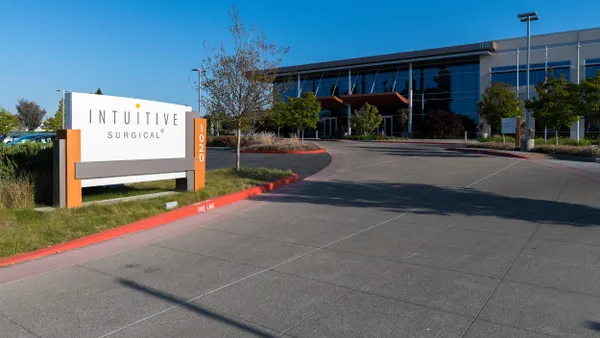Dive Brief:
-
Physicians were unable to complete 1% of transcatheter aortic valve replacements from 2011 to 2015, forcing them to switch to open-heart surgery mid-procedure.
-
The finding, which was published Monday in JACC: Cardiovascular Interventions, provides evidence that the frequency of surgical bailout is low and falling.
-
Some cardiologists argued the results suggest TAVR can be performed by healthcare facilities that lack on-site surgical standby, removing a limitation to uptake of the procedure.
Dive Insight:
The history of interventional cardiology features examples of procedures that could originally only be performed at sites that had surgical standby ready in case something went wrong. Hospitals used to need surgical standby to perform percutaneous coronary interventions. Evidence that surgical standby had no effect on PCI outcomes contributed to abandoning that requirement.
The study adds data to inform the ongoing debate about which sites should perform TAVR. CMS revised its national coverage determination for TAVR earlier this year, loosening some requirements but maintaining its position that hospitals need "on-site heart valve surgery" capabilities to perform the procedure.
An analysis of data from the STS/ACC TVT Registry may have provided evidence that will drive a similar change in TAVR guidelines. Writing in an editorial to accompany the JACC paper, cardiologists Fabian Nietlispach and Osmund Bertel said the findings have "the potential to change practice in several ways."
"From a statistical perspective and given the fact that patients can now be transferred with mobile biventricular assist devices to nearby hospitals, surgical standby is probably no longer a justifiable requirement to perform TAVR," the editorial authors wrote.
The statistical rationale for dropping the need for standby rests on the rate of surgical bailouts in which a patient is switched from TAVR to open-heart surgery mid-procedure. The JACC paper found surgical bailout occurred in 1.17% of the 47,546 TAVR procedures performed between November 2011 and September 2015. The rate of surgical bailout declined over the period, suggesting surgeons become more likely to complete TAVR as they become more familiar with the procedure.
Patients who required surgical bailout had worse outcomes. The 30-day rate of all-cause mortality was 50% in the surgical bailout group compared to 5% among patients who completed TAVR. The analysis also revealed statistically significant differences in one-year mortality and the incidence of major adverse cardiovascular events at both time points.
The editorial combined the 1% incidence of surgical bailout and 50% mortality rate to calculate "the potential for improving mortality with on-site surgery is about 0.5%." That may make surgical standby hard to justify from a statistical perspective but individual patients may feel differently.
"From an individual standpoint, however, many of us would opt for surgical standby if we ourselves needed TAVR," Nietlispach and Bertel wrote.











